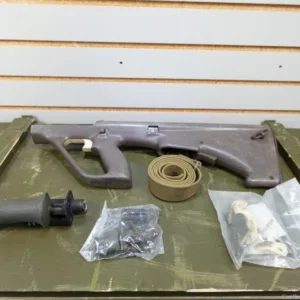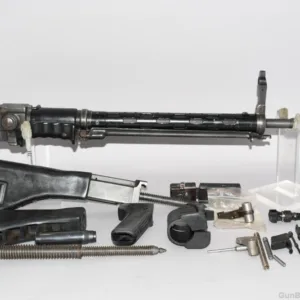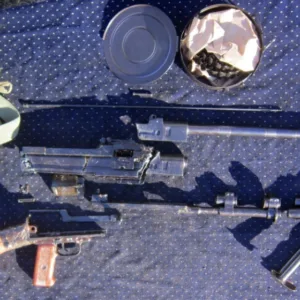The Cetme LC parts kit has gained significant popularity among firearm enthusiasts, particularly those interested in the assembly and customization of their own rifles. This kit includes several components, such as a collapsible stock, superior HK33 parts, and original magazines in both 12 and 30-round capacities.
Learn about the Cetme LC Parts Kit
The Cetme LC (Lite Compact) is a derivative of the CETME rifle series, which has Spanish military origins. The parts kit typically contains essential components for building a Cetme-style rifle or customizing an existing platform. A complete parts kit provides enthusiasts with the necessary parts to assemble a functional firearm while offering the opportunity to personalize various elements to fit individual preferences and specifications.
Components of the Kit
Collapsible Stock: One of the highlights of this parts kit is its collapsible stock, which allows for adjustable length of pull. This feature is particularly beneficial for users of different sizes or for those who wish to fit the firearm in confined spaces.
Superior HK33 Components: The HK33 is renowned for its reliability and durability, making its parts highly sought after. This parts kit may include components such as a barrel assembly, bolt carrier group, and trigger pack, all of which contribute to the rifle’s overall functionality and shooting performance.
Magazines: The Cetme LC parts kit often comes with original magazines, usually in both 12 and 30-round configurations. These magazines are known for their robust construction and reliable feed, which are crucial for smooth operation during firing.
Features of the Collapsible Stock
Advantages of a Collapsible Stock
Adjustability: The primary benefit of this stock is its adjustability, allowing shooters to customize the length for their shooting style, stance, or situation. This is particularly advantageous for different shooting positions or for accommodating gear worn by the shooter.
Compactness: When collapsed, the stock reduces the overall length of the firearm, making it easier to transport and store. This is ideal for tactical situations where maneuverability is key or for users needing to store their rifles in smaller spaces.
Comfort: A well-designed collapsible stock provides better cheek weld, improving the shooter’s ability to aim and fire accurately. The adjustment feature allows users to find that perfect angle, enhancing overall comfort during extended shooting sessions.
Installation Steps
Remove the Existing Stock: If you are replacing a standard stock, start by removing the existing stock from the rifle. This usually involves unscrewing the stock from the receiver.
Prepare the New Stock: Familiarize yourself with the mechanism of the collapsible stock and ensure that you have all required components.
Install the Collapsible Stock: Align the stock with the back of the rifle’s receiver. Slide it into place and secure it with screws or pins as specified in the user manual.
Test Adjustability: Once installed, test the collapsibility and adjustability of the stock. It should slide in and out easily without any binding.
Exploring the Superior HK33 Parts
The HK33 rifle is celebrated for its cutting-edge design and reliable operation. Incorporating parts from the HK33 into the Cetme LC parts kit enhances the overall performance of the assembly.
Key HK33 Components
Barrel Assembly: The barrel is critical for accuracy. The HK33 barrel features robust rifling and chrome-lining, ensuring durability and consistent performance.
Bolt Carrier Group: A reliable bolt carrier group is essential for smooth cycling and reduced malfunctions during firing. HK33 components are designed for precision and ease of maintenance.
Trigger Mechanism: The trigger setup in these parts ensures a clean, crisp pull, improving firing accuracy. Quality components aid in smoother operation, which is crucial for rapid firing scenarios.
Installation of HK33 Parts
Secure the Upper Receiver: If you are building from a stripped upper receiver, begin by securely attaching the newly acquired barrel to the receiver using the appropriate torque specifications.
Install the Bolt Carrier Group: Once the barrel is installed, insert the bolt carrier group into the upper receiver. Ensure that it moves smoothly within the housing.
Attach the Trigger Pack: With the receiver on its side, carefully place the trigger pack within the designated housing and secure it into place following the manufacturer’s instructions.
Original Magazines: 12 & 30-Round Options
The Cetme LC parts kit provides original magazines in both 12 and 30-round options, vital for those seeking versatility and reliability in the field.
Importance of Quality Magazines
Reliability: Original magazines are built to the same specifications as the firearm, ensuring dependable operation throughout their lifespan. They are less likely to jam or fail compared to aftermarket alternatives.
Capacity Versatility: Having both 12 and 30-round magazines allows shooters to adapt to different shooting situations, whether for target practice, training, or home defense. The smaller magazine provides more maneuverability in close quarters, while the larger option isn’t as compact but allows for extended shooting sessions without reloading.
Magazine Maintenance
Regular Cleaning: To ensure reliable feeding, keep magazines clean. Use a soft brush and a cloth to clean out the magazine well regularly.
Spring Inspection: Over time, magazine springs can wear out, leading to malfunctions. Inspect springs regularly and replace them if you notice signs of weakening.
Proper Loading: When loading magazines, avoid using excessive force to load rounds, which can damage the feed lips or springs. Instead, use a magazine loader or do it gently by hand.
Fitting the Parts Kits: A Step-by-Step Guide
Once you have selected your Cetme LC parts kit, the fitting process can be broken down into a systematic approach to ensure optimal performance and reliability.
Step-by-Step Installation Guide
1. Preparation: Gather all necessary tools, including screwdrivers, punches, and gunsmithing tools. Ensure you have a clean workspace to avoid losing small parts.
2. Inspect Parts: Before installation, inspect each component for defects or damage. This is crucial for avoiding future malfunctions during firing.
3. Start with the Receiver: Begin the fitting process with the lower receiver, as this is the core of your assembly. Ensure all critical connecting points are free of debris and fit tightly together.
4. Install Components Methodically: Following the instructions provided with the parts kit, methodically install each component, ensuring that screws are torqued to the proper specifications.
5. Test Functionality: After assembling, conduct a function test to ensure everything operates smoothly. This includes dry firing the firearm and ensuring that all moving parts operate without obstruction.
6. Range Time: Once satisfied with the assembly and functionality, take the firearm to a range for live-fire testing. Be observant of any issues that arise during the shooting experience for future adjustment.











